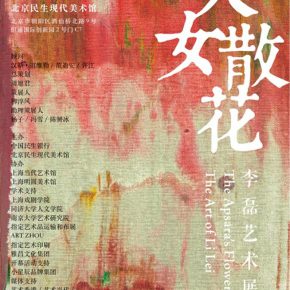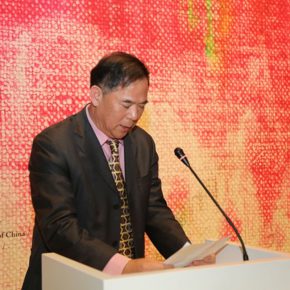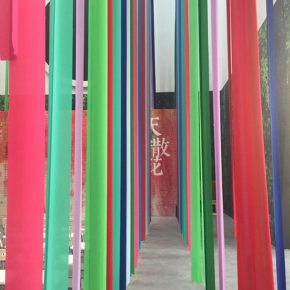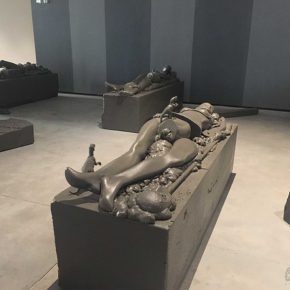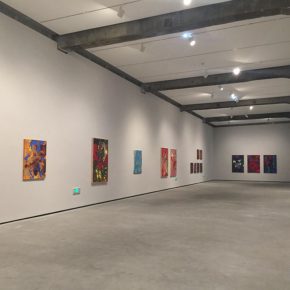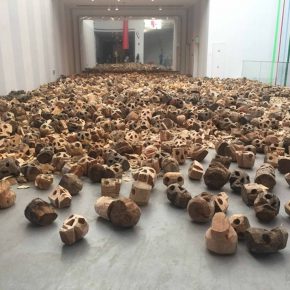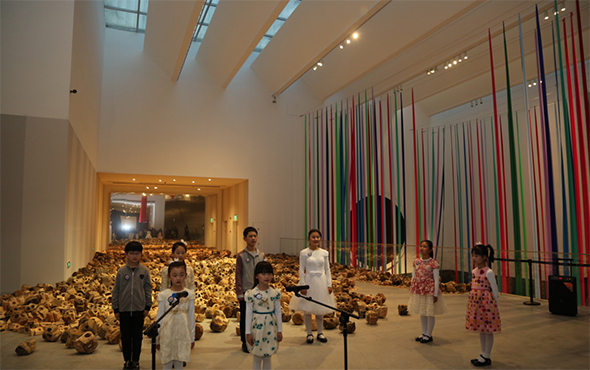
Silk Road, Nu Wa Patches up the Sky, Flower of Sea, Pompeii’s Fireworks, Sea of Skull, Cemetery of Angels, Listening to Cicadas, the Buddha is Speechless … the 12 chapters are used by Li Lei to poetically present a discussion on the “Existence and Demise of Life”, “Conversion and Folding of Time and Space”, “Intertextuality and Conversion of Consciousness and Material”, “Dialogue and Causality of the Abstract and Representation”. Li Lei said that “Thanks to the era that gives the artists possibilities to explore the ideal and showcase artistic achievements. The exhibition is an attempted combination of artistic creation and exhibition space, thinking about the fundamental historical and cultural problems under the background of globalization. I am still on the road, and also constantly working hard.”
On December 23, 2016, jointly hosted by the China Minsheng Bank, Beijing Minsheng Art Museum, and co-organized by Beijing Minsheng Culture and Art Foundation, Shanghai Museum of Contemporary Art, Shanghai Mingyuan Art Museum, “The Apsara’s Flowers – The Art of Li Lei” opened at Beijing Minsheng Art Museum. The exhibition is the first large-scale personal exhibition held by Li Lei in Beijing. Hans d'Orville, Fan Di’an and Xu Jiang serve as academic curators, Liu Chunfeng serves as the curator, while Yang Zi, Feng Xue and Chen Yunbing serve as assistant curators. Li Lei hopes through the theme of “The Apsara’s Flowers” to use the form of “drama” to collectively present the artistic creation by the artist over five years. The exhibited works do not only include the sculpture “Buddha Does Not Speak”, abstract paintings entitled “Flower of Sea”, “Pompeii’s Fireworks”, etc., but also a large number of skulls and sculptures created over the two years.
The “Drama” to Wash Away the Mind
When one enters the exhibition hall, he will be placed in a field carefully created by the artist, feeling the art of Li Lei while receiving layers of spiritual friction and cleaning. When one first pokes the gorgeous ribbon, and then enters the lively and intricate world, after going through a gloomy and tragic world he finally arrives in the world of reflection, namely the “Bustling of Secular”, “Reflection of Mind”, “Overlooking of Spirit”. At the end of the exhibition, the artist sets up a mirror. After experiencing the tremor of the soul, one suddenly meets himself which is like a rebirth after baptism. “Drama” has both a spatial dimension and the feeling of time in circulation. President of CAFA Fan Di’an said that, this type of cross-border is a blending of art form with time and space, which does not only require a huge investment and continuous thinking, but also the ideological theme going through it. The Apsara’s Flowers is not just a term, more importantly it expresses the artist’s thought of the philosophical problems such as life, fate and being.
Li Lei hopes to make this exhibition a “drama”: “Drama is a human game, is the simulation of the ideal and the unknown emotions. So that drama is untrue, it can be said that all the arts are untrue, which determines that we can have a maggot in our head, and break the logic and emotional barriers of the real time and space. We can re-settle the spatial relationship and emotional rhythm to build our own ideas belonging to the specific space and emotional tension.”
“The Apsara’s Flowers”: Spatial Reflection and Narration
In the view of curator Liu Chunfeng, this exhibition is a masterpiece of Li Lei’s artistic creation in the past five years. The exhibition is composed of various forms covering painting, installation, sculpture and video, to perform and transform the traditional static abstract elements, to build a quiet and undercurrent theatrical field. The mood of the public can change with the intersection between exhibition space and works, shuttling between the excitement, noisy, entanglement, permeation and meditation. The exhibition takes full advantage of the multi-faceted space of Beijing Minsheng Art Museum, to showcase Li Lei’s exploration of creative methods and visual ontology, and explores the theme of “The Apsara’s Flowers” in the thinking and narration of space. Among “Questions for Heaven”: it reveals the way of Yin and Yang as “You and me are inseparable”, to feel the unity of heaven and man; “Apocalypse”: the Door of the apocalypse opens the wisdom of the universe, the acrylic box is filled with silks of various colors, which is like the treasure box and library of the universe; “The Bounded Angel”, The angels are bounded, and love without any request. The art is Li Lei’s practice of self-liberation, and also a means of self-liberation. “Cemetery of Angel”: wish you are accompanied by angels, carrying the lives who attempt to break free from the cage to fly to the blue sky, their destiny is to crumble; “Don’t See”: Don’t see, hear sees. “Drunk Lake”: Image of the surface of the river, which has been created by Li for 10 years, embodying the poetic power of life; “Listen to Cicadas at Midnight”: Listen to cicada at midnight, have the same mind as Buddha, Li Lei is good at absorbing nutrients from other art forms, finding things that correspond to him and inspire him; “The Song of Skeleton”: Empty eyes of skeletons, singing the hymn of life; “Stars and Our Ships”: The curved moon with little boats, carrying stars to sprinkle the sky, which is a poetic symbol to reveal the form of life; “Flower of Sea” reflects a type of spiritual temperament of the city of Shanghai; the color of “Pompeii’s Fireworks” in the tangled contradiction, the gorgeous and extreme end which is like the Nirvana of the Phoenix; “Buddha Does Not Speak”: In this group of works, the artist used some fragments of Buddha and natural rocks, which are combined to form a combination of incomplete Buddha statues and natural rocks, to form a new trend.
The exhibition continues to February 16, 2017, during the exhibition it will also launch many colorful public educational activities.
Text by Yu Ya, translated by Chen Peihua and edited by Sue/CAFA ART INFO
Photo by Yu Ya and Minsheng Art Museum


